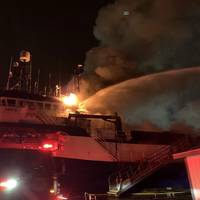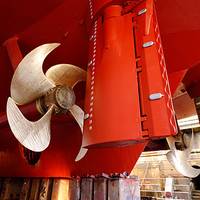Fishing Vessel Fire Sparked by Repair Plan Error -NTSB

Inadequate planning for hot work led to a fire aboard a commercial fish processor while docked at a shipyard in Tacoma, Wash., the National Transportation Safety Board said in its marine investigation report released Thursday.On Feb. 17, 2021, a fire was reported on the commercial fish processor Aleutian Falcon while the vessel was docked for repairs at a shipyard in Tacoma, Washington. The Tacoma Fire Department responded and extinguished the fire four days later. No one was on board the vessel at the time of the fire, and there were no injuries reported.
Harris Pye to Refurbish Kishorn Port Dry Dock Gates
Harris Pye begins work today on refurbishing the historic dock gates at Kishorn Port, last opened nearly 25 years ago. This will be the first step in making them, and the Kishorn dry-dock, operational once more. The contract value is £340,000 and the work will be undertaken in a six week period. The hollow concrete gates were last opened nearly 25 years ago when the Skye Bridge caissons were constructed there in 1993. The dock was also where the Ninian Central production platform, one of the largest concrete structures ever to have moved across the face of the earth, was constructed in the late 1970s. “We are delighted to have won this contract, and to be working on these historic gates,” explains Chris David, Harris Pye’s Chief Technical Officer.
Gibdock Quickly Repairs Pullmantur Zenith

Gibdock’s growing reputation as one of the leading cruise ship repair and refurbishment centres in the Mediterranean has been enhanced by the docking of the 42,255 gt, 1992-built Pullmantur Zenith. The vessel arrived in Gibraltar on November 7th for work that had to be completed within tight time constraints and left on schedule on November 20th, en route to Brazil for its next cruise itinerary. Gibdock was tasked with renewing the rudderneck bushes, which required the drilling…
Offshore-Inland Completes Hull Restoration on USS Alabama
Mobile-Alabama based Offshore-Inland Marine & Oilfield Services has completed hull repairs on the battleship USS Alabama, the state of Alabama's most popular tourist attraction. The 680-ft. battleship was in need of extensive hull repairs after spending 38 years in the muddy waters of Mobile Bay. The USS Alabama sits in about 10 feet of water while her hull rests in another 20 feet of mud. To get to the corroded portions of the hull, a cofferdam was built around the ship and the water pumped out. Approximately 4 feet of mud was excavated from both the port and starboard sides of the vessel. vessel. Offshore-Inland Marine & Oilfield Services removed 10,000 square feet of corroded steel from the battleship's hull.
Marine Innovations
In extending its adherence to delivering cost-efficient and safety driven technologies, DNV has introduced a new means of quickly and accurately determining steel thickness can speed ship surveys. It is especially valuable in inspecting old and corroded steelwork. Present-day methods, based on ultrasonic thickness measurements, are said to have dubious reliability on heavily corroded plates, and for large vessels are also considered too slow. The basic technological challenge was to transmit 100 percent of the signal energy through corroded steel plates, and receive and interpret the reflected signal to give an accurate thickness measurement. The basic principles of the new measuring method (half-wave resonance) have been known for 40 years.
Ship Repair & Conversion Report
Subsequent to the departure of Holland America's Statendam in April, Cascade General took in Crystal Cruises' Crystal Harmony for a 10-day stopover in May. The 10-year-old ship underwent maintenance and overhaul work below its waterline, extensive interior remodeling and steel replacement for pool areas on Deck 11. With maximization of work in mind, Cascade normally sends advanced crews to join cruise ships on their way to the yard's Portland, Ore. locale. This time though, the first mobile crew met the ship in Los Angeles, where work commenced immediately on an overhaul of one of Harmony's auxiliary boilers. A second team was then summoned to San Francisco to clean ballast tanks before undertaking structural repairs and preservation work. easuring 790 ft.
Ships' Cleaning Left Toxic Materials
According to a Medaia News, Sheets of decayed metals, hull coatings and lead paint more than one-third of an inch thick peeled off two obsolete U.S. Maritime Administration ships when marine growth was scrubbed from their hulls at the Port of Richmond last month, according to a report prepared for the federal government. The toxic material was left in San Francisco Bay, much of it adhered to thick seaweed and barnacles that accumulated on the ships for more than 35 years as they were anchored in the Suisun Bay Reserve Fleet near Benicia. When the cleaning was done in early August, MarAd said only organic materials would be left in the water.
New Steel-Thickness Measurement Promises Faster Surveys
Based on half-wave resonance measurements, a new means of quickly and accurately determining steel thickness can speed ship surveys. It is especially valuable in inspecting old and corroded steelwork. The new DNV system, launched at Nor-Shipping '99 is unique. Present-day methods, based on ultrasonic thickness measurements, are not reliable on heavily corroded plates, and for large vessels are also considered too slow. The basic technological challenge was to transmit 100 percent of the signal energy through corroded steel plates, and receive and interpret the reflected signal to give an accurate thickness measurement. The basic principles of the new measuring method (half-wave resonance) have been known for 40 years.
New Steel-Thickness Measurement Promises Faster Surveys
Based on half-wave resonance measurements, a quick, accurate means of determining steel thickness can speed ship surveys. It is especially valuable in inspecting old and corroded steelwork. Present-day methods, based on ultrasonic thickness measurements, are not reliable on heavily corroded plates, and for large vessels are also considered too slow. A new Det Norske Veritas (DNV) system addresses the technological challenge of transmitting 100 percent of the signal energy through corroded steel plates, and receiving and interpreting the reflected signal to give an accurate thickness measurement. The basic principles of the new measuring method (half-wave resonance) have been known for 40 years.





